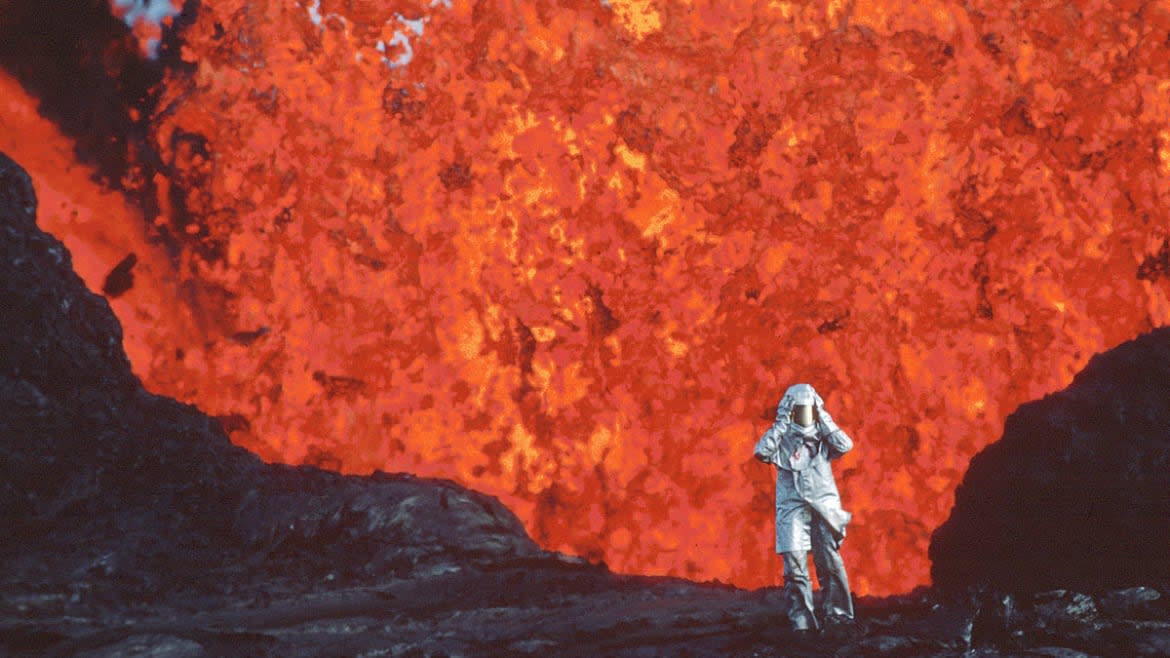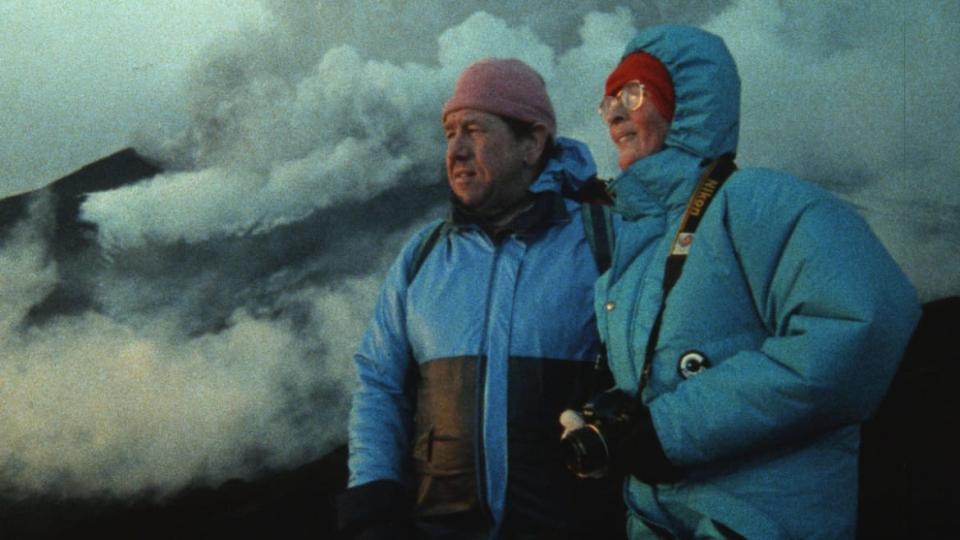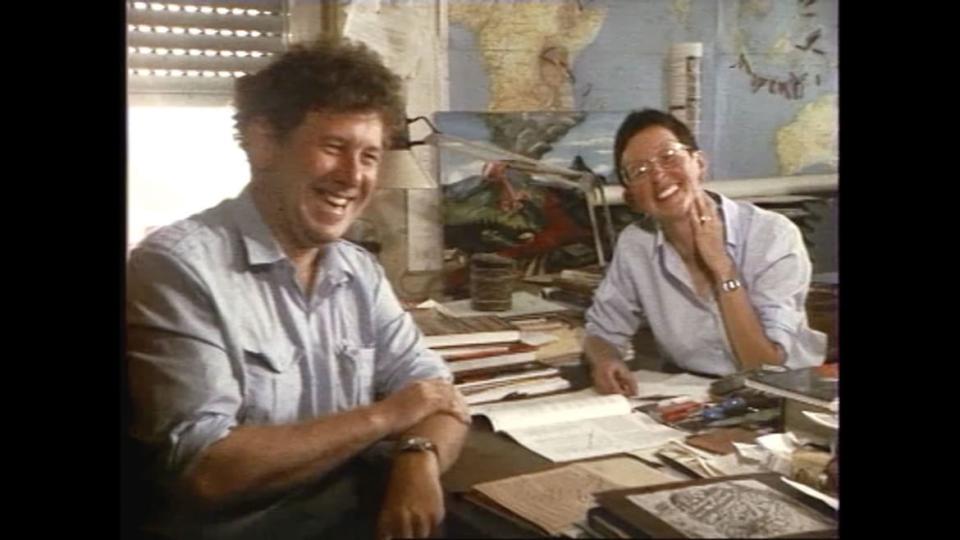The Couple Who Fell in Love—and Died—on a Volcano

- Oops!Something went wrong.Please try again later.
- Oops!Something went wrong.Please try again later.
There’s an abundance of metaphors to be made surrounding volcanoes. They erupt from you, one could say.
It’s a whole other thing to make that figurative language and those themes literal: Katia and Maurice Krafft fell in love and died on a volcano.
Fire of Love, the spellbinding documentary directed by Sara Dosa and produced by Shane Boris, recounts their love story. They were volcanologists who met through field work in the ’70s and transformed their field, working together to collect data and footage of their dangerous subjects. Along the way, they attained a bit of a cult celebrity, before their death in 1991.
The footage they left behind is jaw-dropping. Filmed on handheld cameras in 16mm, it rivals any drone footage you might see in recently shot documentaries with current technology. But also present is their humanity, an often ignored subset of science. “In the footage, there’s dust from the actual volcanoes where they shot,” Dosa tells The Daily Beast’s Obsessed. “There are grains of hair that I’m sure are theirs. Those things might feel imperceptible on a screen, but, at the same time, it can also be deeply felt.”
Dosa and Boris are speaking with us in Savannah, where Fire of Love was being given a spotlight screening at the SCAD Savannah Film Festival. The film premiered in January 2022 at the Sundance Film Festival, which, because of COVID-19’s Omicron wave, was held virtually. The duo are now touring the film on an awards campaign with distributors National Geographic and NEON. As of this weekend, it’s available to stream on Disney+.
“In Indonesia, someone came up to us who hosted Katia when she worked there decades ago,” Dosa says. “There’s such a personal connection to this film.”
Fire of Love not only rapturously captures the intense connection shared by the married couple, but, through that, underlines the imperative of curiosity and reason when it comes to the dangerous unknowables of the world in which we live. The Kraffts didn’t just collect data, they traveled to spewing volcanoes while everyone else was fleeing in order to understand how they work. They risked their lives to save others.
The most hotly burning emotions are here at play—romance, death, and the beauty in both. With Fire of Love now available to stream, we spoke to Dosa and Boris about the intensity of the film’s emotions—especially in the world of documentary. But also, what it’s like to be a fly on the wall for a couple so invested in their mission, it became their entire lives—and, then, their end.

This is a film that occupies several categories. It’s a love story. There’s suspense and action. There’s a volcano spewing. It’s also educational. As you were assembling this, how did you juggle the different categories?
Dosa: We really think of Fire of Love as a collage film. Whether it’s the theme of love, or the unknowability of nature, volcanology, or scientific inquiry, we were very worried that this was going to be idea soup. The clarifying prism of a love story really helped to shape the overarching arc. Where the main themes of science and love seem to really intersect is through the theme of the unknown—whether it’s the unknown mystery that is force of creation expressed through volcanism, or it’s the unknown of the human hearts, which brought Katia and Maurice together.
Boris: And even though you can’t understand it, you’re always going to try. Katia and Maurice have a deep background in existentialist philosophy. You feel the depth of their inquiry. You also see that they understand the absurdity of that kind of existential stance. So you also get a sense of where their playfulness comes from.
Mars Rover Documentary ‘Good Night Oppy’ Desperately Wants to Be a Pixar Film
There’s something Shakespearean about this logline, that they fell in love and died on a volcano. It’s romantic, but there’s a bit of portending doom. How do you balance that romanticism with that morbidity?
Dosa: In the edit room, we came to realize that the proximity to death animated their life. It really pulled into focus what was most meaningful to Katia and Maurice, and that was love—particularly the love of volcanoes and each other. They knew that they needed each other to pursue this love. For them, love and death went almost hand in hand.
That’s incredibly touching.
Dosa: So for us, there was the morbidity, but it was also understanding their view of the world, that death wasn’t necessarily the end. They understood that volcanoes were a source of creation and destruction. This is a grand cycle of reforming the world, and they were part of that. And so understanding their death might cause them to ration their hours, the way they ration their feed of film, making their life as meaningful and full of love and spectacle as possible.
Boris: For them, death is not the end. It’s the beginning. It’s the end of their physical form, perhaps, but it’s the beginning of the myth that they are also very invested in creating for their lives. And more importantly, for the sentience of nature and importance of volcanoes, and that endless process of creation and destruction.
The Very Best of Sundance 2022: Dakota Johnson, Cosby Comeuppance, Volcano Love, and More
It was a metaphor for their lives, almost.
Boris: One thing we were conscious of putting in the film is that they understood the danger of living so close to the volcano, and being close to something that could kill them. But that wasn’t the ultimate concern for them. They knew they were going to die, and that wasn’t what drove them. What drove them was how to live a meaningful life. They invested so much time and energy into saving human lives. And understanding what a human life is capable of. I think you can only get to that understanding if you’re prepared for your own death.
Dosa: The thing that was morbid for them was the idea that the other one could die. Maurice’s greatest fear is that Katia would be injured and in agony, and he would not be able to save her. The same thing for Katia. Her greatest fear is that Maurice would wander off, driven by his desire to see as much as possible and film as much as possible, and would step through the lava. They had so many worries about each other, but they had kind of reconciled the idea that they themselves could die.
Any time there’s a documentary about people who live life on an edge, I realize that these are humans that just have such a different relationship to risk than I have in my life. I’m curious, like, maybe not necessarily as filmmakers, but as people: How did getting to know them through this footage change how you think about risk yourselves?

Dosa: I love that question. Katia and Maurice are profound teachers and guides. They taught me about the fear and curiosity that can live behind risk, or motivate risk. There’s a memorable line in the film where Katia says, “Curiosity is stronger than fear.” I feel like she’s not saying that she doesn’t have fear. But she’s saying that she sees fear, understands it in relation to curiosity, and is able to reposition herself in a stance of strength to really hold the curiosity—and thus enact risk. I think that’s so powerful.
Boris: I think they show that fear is natural, that the experience of fear is important. It’s very biological, too. We can assess risk and be afraid of different things. But then there is a choice of what we do with that. They understood the risks, and then they still endeavored to go do what they needed to do. That’s very different from a kind of foolishness, approaching something without any sense of understanding.
I find it fascinating to watch this, where the footage is decades old, but it might be even more compelling than anything a drone has captured, or anything cutting-edge technology has captured, of these volcanoes. What can you say about the power of that?
Dosa: Working with 16 mm is so tactile. The permanence of it. In the footage, there’s dust from the actual volcanoes where they shot. There are grains of hair that I’m sure are theirs. Those things might feel imperceptible on a screen, but, at the same time, it can also be deeply felt. It was also unbelievably cumbersome for them to carry this very heavy equipment. The grit just further gives weight to this. I don’t mean to make that pun. But at the same time, it does give a sense of gravity and meaning to their pursuit.
Boris: We live in the moment that’s defiant of history, and is not accepting the value of what history has to offer. This film deals with geologic time, which is history on one of the biggest scales. We’ve been able to retell their story through themes and narratives that are timeless.
Get the Daily Beast's biggest scoops and scandals delivered right to your inbox. Sign up now.
Stay informed and gain unlimited access to the Daily Beast's unmatched reporting. Subscribe now.

